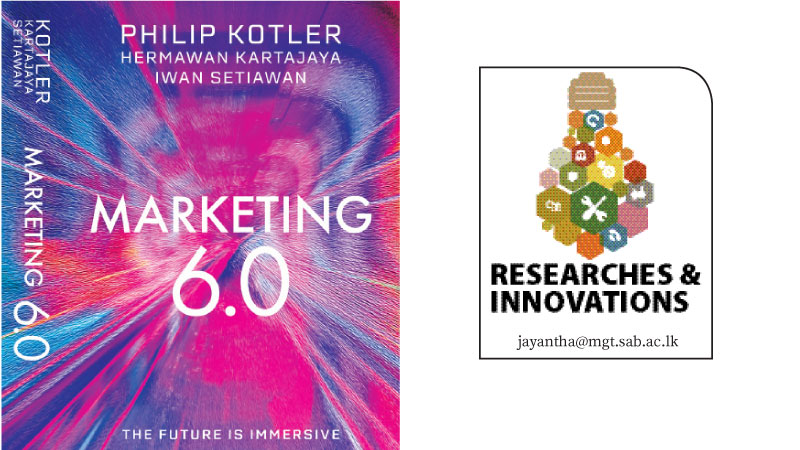“Marketing 6.0: The Future Is Immersive” by Philip Kotler, Hermawan Kartajaya, and Iwan Setiawan presents a compelling examination of marketing’s evolution in the digital era. Drawing from Kotler’s influential work in the field, the book introduces the concept of Marketing 6.0, underscoring the significance of crafting immersive consumer experiences.
An essential theme highlighted in the book is the diminishing effectiveness of traditional marketing models in today’s hyper-connected world. The authors argue that with the proliferation of social media, mobile technology, and virtual reality, consumers are inundated with information, prompting the need for marketers to engage them on a deeper, more immersive level.
Central to Marketing 6.0 is the principle of co-creation, emphasising collaboration with consumers to develop meaningful experiences aligned with their values and aspirations. Through such partnerships, companies can cultivate stronger relationships and foster brand loyalty. The book delves into the pivotal role of technology in shaping the future of marketing. From augmented reality to artificial intelligence, emerging technologies are transforming how companies interact with consumers, enabling the creation of captivating, immersive experiences that drive results.
Critical review
Marketing 6.0: The Future Is Immersive” unfolds in three parts. Part 1 is an introduction to Marketing 6.0, delineated across four chapters, with some reflective questions at the end. The inaugural chapter illuminates the evolutionary journey of marketing, progressing from Multi to Omni to Meta paradigms.
In multi-channel marketing, marketers operate online or offline independently, while omnichannel marketing integrates both realms concurrently. Contrarily, immersive Marketing or Mera Marketing adopts an immersive approach, blending online channels into offline experiences and vice versa. The authors elucidate three layers of Metamarketing, positing them as the cornerstone of Marketing 6.0.
 The first foundational layer encompasses enablers that seamlessly fuse physical and digital experiences. This layer sets the stage for the second layer, characterised by two distinct environments: extended reality and metaverse. The final layer revolves around customer experiences, featuring multisensory marketing, spatial (3D) marketing, and marketing metaverse as critical components.
The first foundational layer encompasses enablers that seamlessly fuse physical and digital experiences. This layer sets the stage for the second layer, characterised by two distinct environments: extended reality and metaverse. The final layer revolves around customer experiences, featuring multisensory marketing, spatial (3D) marketing, and marketing metaverse as critical components.
The second chapter focuses on the emergence of digital natives, highlighting the distinctive traits of two pivotal demographic cohorts: Generation Z and Generation Alpha. As society strides into mid 21st century, attention naturally gravitates from Generation Z—individuals born between 1997 and 2012—to Generation Alpha, the cohort born from 2010 onward.
The authors emphasise that these generational cohorts represent more than just age brackets; they embody unique cultural and behavioural characteristics moulded by the technological, societal, and global contexts of their upbringing. For Generation Z, technology is not just a tool but an integral aspect of daily life, profoundly influencing communication styles, social interactions, and consumption habits.
They are digital natives, seamlessly navigating the digital landscape and demanding authenticity, relevance, and personalisation from brands. As Generation Alpha begins to come of age, their formative years are marked by even greater immersion in technology and connectivity. Born into a world where smartphones, social media, and artificial intelligence are ubiquitous, Generation Alpha is poised to redefine norms and expectations in the digital realm.
They exhibit an innate fluency in navigating digital interfaces and platforms, shaping how they engage with content, brands, and each other. Understanding the nuances of these digital-native generations is paramount for marketers seeking to resonate with and engage young consumers effectively. By recognising their distinct preferences, values, and communication styles, brands can tailor their strategies to forge authentic connections and foster brand loyalty in an ever-evolving digital landscape.
In the third chapter, the book explores five micro trends driving the rise of immersive marketing: short-term video content, community-based social media, interactive e-commerce, language-based artificial intelligence, and immersive wearable devices. These trends cater to the preferences of Generation Z and Generation Alpha, offering concise, visually engaging narratives, authentic community engagement, seamless, personalised shopping experiences, instant, tailored interactions, and immersive, identity-enhancing experiences. By embracing these trends, brands can captivate audiences, drive engagement, and foster lasting connections in the digital age.
In chapter four, the book explores the future of customer experience, stressing the integration of physical and digital for complete immersion. The authors showcase how businesses can adopt a five-element approach, using Coca-Cola and Apple as prime examples. Through fostering two-way communication, encouraging active participation, minimising distractions, crafting cohesive narratives, and stimulating all five senses, brands can craft immersive experiences that deeply resonate with consumers, fostering engagement, loyalty, and advocacy.
The authors underscore that achieving immersive experiences requires a tailored approach, as there’s no universal formula across industries. They advocate for a hybrid future, blending digital and human interactions to create truly immersive experiences that captivate and connect with consumers on a profound level. However, identifying when to prioritise customer interactions and when to prioritise technology is essential. In uncovering this knowledge gap, the authors emphasise four scenarios: human presence facilitates transactions, human engagement as a strategy for bridging the trust gap, and human relationships to enhance the product and human experience as the product.
Part II focuses on the marketing 6.0 enabler and environment, comprising three chapters on the technologies driving Metamarketing, immersive experiences in real life, and the future of social media platforms. Chapter 5 elucidates the five fundamental technologies that underpin Metamarketing: The Internet of Things, artificial intelligence, spatial computing, augmented and virtual realities, and blockchain technology.
With practical examples, the authors illustrate how the Internet of Things can capture real-time physical interaction data, facilitating immersive customer experiences. They further delve into how artificial intelligence can process data effectively, citing examples from PepsiCo, Cadbury, and Cooler Screens.
Spatial computing is explored for experience modelling, while augmented and virtual reality are showcased for interface enhancement, with relevant implementation examples such as Proctor and Gamble. Finally, the authors discuss blockchain technology’s role in providing secure and transparent infrastructure for immersive customer experiences. Through these technologies, businesses can leverage Metamarketing to create engaging, immersive experiences that resonate deeply with consumers in the digital age.
Chapter six focuses on building extended realities to offer immersive customer experiences in real life, particularly emphasising the concept of the “third place.” This notion refers to physical locations beyond the home and workplace, where individuals can engage in social interactions and experiences. We may have initially questioned the existence of such a third place, but the book provides a compelling explanation, emphasising its role as a space fostering connections and community.
The chapter elaborates on the inclusive and accessible nature of the third place, which welcomes individuals from all walks of life at little to no cost. This environment is characterised by its welcoming and playful ambience, creating opportunities for interaction and connection. The book explores how to reinvent the third place by extending physical realities into the digital realm.
Through seamless transactions, contextual recommendations, interactive engagements, augmented discoveries, and pre-and post-experiences, businesses can create immersive environments that bridge the gap between the physical and digital worlds. Finally, the chapter delves into the design of immersive third places through the “3Ps”: people, process, and physical evidence. By focusing on these elements, businesses can deliver authentic in-real-life experiences (IRL) that resonate deeply with consumers and foster meaningful connections in today’s digital age.
Chapter seven delves into the future evolution of social media platforms, mainly focusing on their integration with the metaverse. While acknowledging the growing popularity of the metaverse among Generation Z and Generation Alpha, the book falls short of providing a detailed explanation of why this trend is gaining traction.
Despite the omission of explicit reasoning, it’s evident that the metaverse offers unique opportunities for social interaction and engagement that resonate with younger generations. With its immersive and interactive nature, the metaverse provides a platform for users to connect, socialise, and express themselves in ways that traditional social media platforms cannot match. The metaverse represents a convergence of physical and digital spaces, blurring the lines between reality and virtuality.
For Generation Z and Generation Alpha, accustomed to navigating seamlessly between online and offline worlds, the metaverse offers a natural extension of their digital experiences. Chapter Seven elaborates on the essential components of the Metaverse, including virtual assets, avatars, user experience, creator economy, and governance, using practical examples to illustrate their significance. These components contribute to the immersive and dynamic nature of the metaverse, shaping how users interact, create, and govern within these virtual environments.
Part III of the book explores the marketing 6.0 experience, explicitly focusing on multi-sensory, spatial, and metaverse marketing. Chapter 8 focuses on delivering immersive marketing experiences by utilising the five senses: sight, touch, sound, smell, and taste, termed multisensory marketing.
Interestingly, the chapter draws a parallel between the concept of controlling the five senses, as explored by the Buddha in achieving Nirvana, and the application of multisensory marketing to create immersive customer experiences. While the Buddha’s teachings aim to transcend the cycle of suffering and rebirth, the book explores how engaging the five senses can enhance customer experiences, citing examples from various industries.
The chapter outlines a three-step process for building multisensory experiences: first, determining key objectives; second, identifying multisensory touchpoints; and third, delivering immersive experiences that engage multiple senses. This structured approach enables businesses to design and implement impactful multisensory marketing strategies that captivate and connect with consumers on a deeper level.
Chapter Nine explores Spatial Marketing with a focus on achieving natural human-machine interactions. Using a triple Venn diagram, the authors illustrate spatial marketing as the intersection of augmented, contextual, and proximity marketing. The chapter emphasises the significance of identifying location, tailoring content, and delivering the right product at the right time and place.
By seamlessly integrating digital experiences into physical environments, businesses can achieve spatial marketing, creating immersive and personalised interactions that resonate deeply with consumers. The authors elaborate on three steps of Spatial Marketing Design: understanding customer pain points, identifying spatial marketing operations, and implementing spatial marketing experiences.
The last chapter centres on Metaverse marketing, positioning it as the next-generation engagement strategy. The authors elaborate on five keys to successful Metaverse marketing: maintaining a long-term horizon, seamlessly integrating real-world marketing efforts, engaging with existing communities, prioritising simplicity, and establishing clear objectives and roadmaps. The authors also stress three essential steps for Metaverse marketing: understanding customer motivations within the metaverse, designing participation strategies, and selecting the most suitable execution route. Customer motivations within the metaverse are outlined as seeking a fun escape, fostering connections, facilitating convenient shopping, and exploring opportunities for financial gain.
The authors then provide implications for marketers on how brands can engage in the metaverse across four pillars: offering branded collectables, implementing experiential advertising, establishing online-to-offline commerce, and creating gamified loyalty programs. Finally, the chapter delves into implementation strategies for Metaverse campaigns, underscoring the importance of campaign determination, selecting the appropriate Metaverse platform, and experimenting with and evaluating campaign performance.
Throughout the book, the authors underscore the diminishing effectiveness of traditional marketing models in today’s hyper-connected world. They argue that with the proliferation of social media, mobile technology, and virtual reality, consumers seek more profound, immersive brand engagement.
Central to Marketing 6.0 is the principle of co-creation, wherein companies collaborate with consumers to develop experiences aligned with their values and aspirations. By embracing emerging technologies and fostering genuine partnerships, businesses can cultivate stronger relationships and encourage brand loyalty.
As the reviewers of this book, we believe that the book has not focused on the ethical implications of immersive marketing, such as concerns about data privacy, consumer manipulation, and digital addiction.
The examples and case studies in the book may primarily focus on Western markets, potentially neglecting the diverse cultural contexts in which marketing operates globally. Hence, we suggest working on a special edition for the developing markets. With this understanding, we conducted two interviews with the book’s authors to seek clarification.
Findings from the interviews
First, we interviewed Dr. Iwan Setiawan, one of the concept developers of the book. We asked whether they plan to work on a special edition of the book tailored to developing markets and what insights or considerations would be essential to include. Dr. Setiawan responded that addressing the unique cultural contexts of developing markets in marketing strategies is critical. He emphasised the importance of localisation, affordability, and cultural sensitivities in crafting effective marketing campaigns for these regions.
Then, we inquired about the advice offered to aspiring marketers or business professionals looking to succeed in an increasingly immersive and interconnected world. Prof. Setiawan stressed the significance of staying adaptable and embracing technological advancements while prioritising ethical considerations and maintaining authenticity in consumer interactions.
Second, we interviewed Prof. Hermawan Kartajaya, The Asian Marketing Guru and the founder of the Asian Marketing Federation (AMF), about the book. We discussed how marketers could effectively engage with digital-native generations like Generation Z and Generation Alpha and what key trends or behaviours marketers should be aware of.
Prof. Kartajaya highlighted the importance of understanding these generations’ preferences for authenticity, personalised experiences, and social consciousness. He emphasised the need for brands to communicate transparently and engage meaningfully with these demographics through relevant digital platforms.
Finally, considering its unique nature, we asked why the book did not include references with citations. Prof. Kartajaya explained that the book aimed to present concepts and insights straightforwardly accessible to a broad audience in a pragmatic manner as their viewpoint rather than focusing on academic citations. He noted that the emphasis was on practical applicability and real-world examples rather than scholarly references.
Conclusion
The book unfolds in three parts, each focusing on different aspects of Marketing 6.0. Part I introduces Marketing 6.0 and delineates its foundational principles, while Part II delves into the technologies driving Metamarketing and immersive experiences. Finally, Part III explores multi-sensory, spatial, and metaverse marketing strategies.
Notably, the book delves into the unique characteristics of Generation Z and Generation Alpha, highlighting their digital fluency and distinct preferences. It also examines emerging trends driving the rise of immersive marketing, such as short-term video content and interactive e-commerce. The book provides practical insights and strategies for marketers to navigate the evolving landscape. From designing immersive customer experiences to leveraging the metaverse for engagement, the authors offer actionable advice for staying ahead in a rapidly changing environment.
“Marketing 6.0: The Future Is Immersive” is a valuable resource for marketers seeking to adapt and thrive in the digital age. By embracing innovation and prioritising customer-centric approaches, businesses can create meaningful connections and drive success in an increasingly immersive world.
Note: This is an extraction of the article published in the 18th Volume of the Rajagiri Management Journal by Emerald Publishing.




